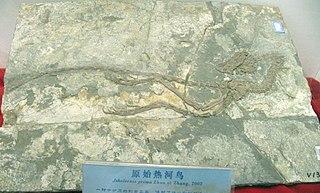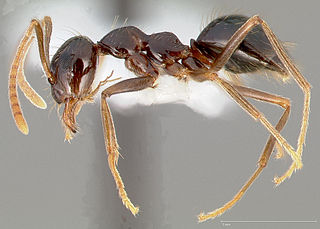
Shunosaurus, meaning "Shu Lizard", is a genus of sauropod dinosaur from Late Jurassic (Oxfordian) beds in Sichuan Province in China, approximately 159±2 million years ago. The name derives from "Shu", an ancient name for the Sichuan province.
Zizhongosaurus is a genus of basal herbivorous sauropod dinosaur which lived in the Early Jurassic Period of China. It was a large-bodied herbivore characterized by a long neck.

Jeholornis is a genus of avialans that lived between approximately 122 and 120 million years ago during the early Cretaceous Period in China. Fossil Jeholornis were first discovered in the Jiufotang Formation in Hebei Province, China and additional specimens have been found in the older Yixian Formation.
Paraprotopteryx is a genus of enantiornithean birds from the Mesozoic of China.

Eoconfuciusornis a genus of extinct bird that lived 131 Ma ago, in the Early Cretaceous of China.

Bangana is a genus of fish in the family Cyprinidae, the carps and minnows. It is distributed across much of southern and eastern Asia. Species live mainly in the flowing waters of tropical and subtropical rivers.
Discogobio is a genus of cyprinid fish that are found in eastern Asia. So far the 16 species have only been identified from China and Vietnam wherein each species is endemic to the country in which it is found.

Prenolepis is a genus of ants in the subfamily Formicinae. Most species are found in southeastern Asia and southern China, but the genus has a wide distribution with species known from North America, southern Europe, Anatolia, Cuba, Haiti, and West Africa.

Philidris brunnea is a species of ant in the genus Philidris. Described by Donisthorpe in 1949, the species is endemic to New Guinea.

Philidris cordata is a species of ant in the genus Philidris. Described by Smith in 1859, the species is endemic to Indonesia and New Guinea. This species is a frequent inhabitant of the ant plant genera: Myrmecodia and Hydnophytum.
Philidris cruda is a species of ant in the genus Philidris. Described by Smith in 1860, the species is endemic to Indonesia.
Philidris jiugongshanensis is a species of ant in the genus Philidris. Described in Wang and Wu in 2007, the species is endemic to China.
Philidris pubescens is a species of ant in the genus Philidris. Described by Donisthorpe in 1949, the species is endemic to New Guinea.
Philidris laevigata is a species of ant in the genus Philidris. Described by Emery in 1895, the species is endemic to Burma, India and China.
Philidris myrmecodiae is a species of ant in the genus Philidris. Described by Emery in 1887, the species is endemic to Asia.
Dolichoderus flatidorsus is a species of ant in the genus Dolichoderus. Described by Zhou and Zheng in 1997, the species is endemic to China.
Dolichoderus pilosus is a species of ant in the genus Dolichoderus. Described by Zhou and Zheng in 1997, the species is endemic to China.

Eogranivora is a bird genus, belonging to the Ornithuromorpha, that lived in the area of present-day China during the Early Cretaceous. Its type species is Eogranivora edentulata.
Mengla virus is a type of filovirus identified in a Rousettus bat in Mengla County, Yunnan Province, China and first reported in January 2019. It is closely related to Ebolavirus and Marburgvirus.









